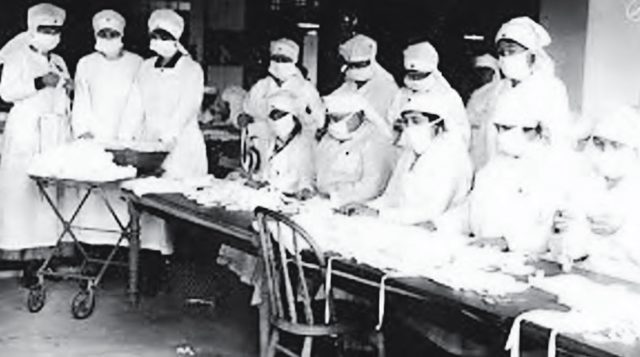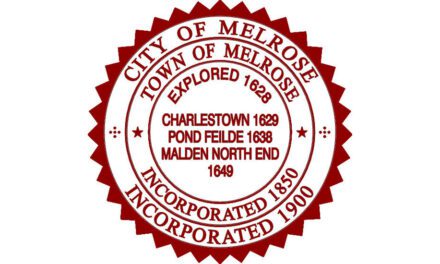Published April 3, 2020
The author is a member of the Melrose Historical Commission.

JUST LIKE NOW, medical personnel were on the front lines of the 1918 influenza epidemic that swept the globe.
By JIM BENNETT
MELROSE — This is not the first time that Melrose has faced down a lethal and highly contagious virus.
In September of 1918, the city was blindsided by an influenza epidemic that in the course of less than six months killed about 80 residents and made thousands sick. Unlike the virus we face today, this one was especially deadly to the young, mainly killing people in the prime of life, sometimes in as little as 48 hours. Compounding the severity of the disease was a complex of cultural and political attitudes that rendered containment efforts ineffectual. In that sense, this story should give us hope: mitigation efforts undertaken in 2020 appear to be working far better than the 1918-1919 episode, and suggest that fewer people here will get sick or die in the months to come.
In 1918 Melrose was a town of just under 18,000 people. The professional workers of the city largely commuted to downtown Boston aboard the railroad, while families of more modest means found work at the numerous small industrial and commercial concerns dotting the town, and at the massive Boston Rubber Shoe Company at the city’s southern gateway. While automobiles could increasingly be found in the city streets, cars had not yet transformed the way of life here. Lacking internet, television, or an easy way out of town, Melrose boasted an extraordinarily rich social fabric. Every night various fraternal, cultural, political, and arts organizations met all over the city, and on Sunday mornings the churches were full to overflowing.
This hectic interaction facilitated the spread of the many contagious diseases we have since vaccinated out of memory. Every year there would be at least several dozen new cases of Diptheria, Scarlet Fever, Typhoid Fever, Whooping Cough, and Tuberculosis. The most lethal of these was the last, which was responsible for the deaths of 10 to 13 Melrosians each year during the 1910s. The general attitude towards contagious diseases in 1918 was much like that to cancer today: they were regarded as horrible things to endure, but on a societal level were judged to be inevitable.
In early 1918, most Melrosians would not have had time to think about contagious diseases, because they were focused single-mindedly on the American forces that had just been dispatched to the front lines in Europe. As Mayor Charles Adams said in his Inaugural Address in January, 1918, “When the War came, our people put up hundreds of flags. Meetings for recruiting were constantly held…. More than 500 of our boys are taken from the activities of our city and are now in the service of the Country. Our educational interests, social affairs, amusements, plans for a more beautiful city, local business enterprises, are now overshadowed and must give way to the support of the men at the front.”
Melrose buzzed with activity to support the war. The Red Cross claimed over 1200 members, most of them women, who volunteered to sew thousands of garments and surgical dressings. In less than 24 hours, the Melrose YMCA raised over $22,000—the equivalent of a half-million dollars today—to support its War Fund. Moreover, the entire local economy had been turned over to the war effort. A munitions factory was opened at the bottom of East Emerson Street, and factories throughout town began sending their goods to the front.
The war effort would become so totalizing that it would shut down tolerance for dissent. On a national level, President Woodrow Wilson had curtailed the rights of the free press and set up a formidable propaganda machine to silence opposition. In Melrose, adults and youth alike who might oppose the war were targets for indoctrination. In 1917 Melrose School Superintendent John Anthony bemoaned the “The great numbers of young men who are ignorant of the English language and American ideals…. the lack of knowledge of community sanitation and personal hygiene, of civic ideals and duties” among his students.
The following year, he wrote that “without an efficient educational system, World Peace and the fight against Bolshevism will be hopeless.” By then, the Melrose schools had added a new Department of Americanization, which taught the English language and American ideals to adults, using a room at the Boston Rubber Shoe Company.
In sum, Melrose in 1918 was a prosperous, busy community inured to contagious diseases that was preoccupied with a foreign war and unwilling to heed bad news that might counter the war effort. They were not prepared for the influenza virus. Most historians agree that the virus made landfall from Europe on board a navy ship that docked on Commonwealth Pier on September 6, 1918. By September 17, it had claimed its first Melrose victims. The first to die that day was William H. Davis, 19, who worked at the East Emerson Street munitions factory; the second was George H. Collegan, a canner at the Friend’s Baked Beans factory on Corey Street. Two days later, Collegan would be joined in death by a baker who also worked at Friend’s. The epidemic would also claim the lives of two employees at the Sircom Dress Factory, located next door on Corey Street, and two rubber workers from the Boston Rubber Shoe Factory. At a time when war production needs dictated that factories not shut down, crowded, dirty workplaces were ideal environments for virus transmission.
Besides these examples, it is difficult to find a pattern to transmission. During the first two weeks of the epidemic, there were about 10 cases within a block of Lynde Street, suggesting that a “patient zero,” perhaps someone who worked at Friend’s, spread the disease in the area. By the end of the disease’s run, no part of Melrose was safe. Two next door neighbors on Mystic Avenue, Ethel C. Haven, 33, and Jacob P. Holmes, 45, died in late September within a few days of one another. Likewise, Laura F. Maxwell, 18, and George F. Berndt, 24, who lived nearly across the street from one another on Otis Street, died during the same 24 hour span. Deaths in such geographical and temporal proximity suggest simple neighbor-to-neighbor contact.
Strikingly, there was only one case of multiple deaths in a single family. It is a heart-breaking story. At 8 p.m. on September 29, Charles H. Ilsley, 20, a student at MIT, died at his family home on North Avenue. He was followed the next evening at about 9:15 p.m. by his younger sister Barbara, aged 11. It is impossible to imagine the grief of their parents, Donald and Sarah. They at least had other surviving children to comfort them.
Altogether, about 80 people died of the influenza epidemic in Melrose, and over half of them died within a one month period starting on September 17. Melrose Hospital, located on the site of today’s Melrose-Wakefield Hospital, was the site of 16 of those deaths, and was the place where most Melrosians who got sick sought treatment. Clarence P. Holden, the Chairman of the Board of Health, wrote “It is impossible to exaggerate the distress due to the epidemic at its height…. The work of the Melrose Hospital was invaluable. With a large part of their nursing force incapacitated with influenza, still the wards were crowded and the work went on.”
After surviving the initial onslaught of the disease during that first month, Melrose Hospital nurse Florence K. Conway, 24, of Vinton Street, succumbed to the disease on December 3. Further afield, Dr. Howard B. Jackson, 44, of West Emerson Street died at Oglethorpe Army Base in Georgia, one of the many Melrose medical professionals not in town to treat the epidemic because they had volunteered for the war effort.
The epidemic tore a devastating hole through the young adult population of the city. All but eight of those who died were under the age of 50, with the largest cohort by far (44 deaths) between the ages of 20 and 40, many of them young parents or else living at home with their birth families. The disease struck men and women equally. They were variously employed, with many of them having jobs that required frequent travel or interaction with the public. Unfortunately for them, mitigation efforts did not include a stop to their work. The city had shut down schools and convinced church leaders not to hold Sunday services by the weekend of September 29. But by then 15 people had already died in the city, and the infection curve was clearly rising. Moreover, while large public gatherings were canceled, the war effort demanded that production continue. The disease would simply have to run its course.
By the end of October, cases of the disease began to abate. In November, only four Melrosians died from the disease. In December, it roared back, claiming 14 lives. There were a handful of cases over the course of the winter and then, just as suddenly as it arrived, the disease left the community, with no more fatalities after March, 1919.
In his Inaugural Address for 1919, Mayor Adams gave a passing mention to the influenza outbreak, and then devoted most of his address to fulminating on the need for a monument to honor the war dead. He might have reflected on the fact that more of those men would die of influenza than of any cause, and that many more young men and women had died on the streets of Melrose of the disease than in the trenches on the front. Yet to do so would have been to confront the sense of utter hopelessness that only a non-human enemy can inspire. What lesson could Melrose learn? Many had suffered needlessly, some had died, and the survivors had gone on and tried to focus on things they could actually control.
When Melrose emerges from our current crisis, we will have an opportunity to learn more from the experience than our predecessors did. They lived at a time when viruses were not understood and a sense of hopeless inevitability was the default position. By comparison, we are fortunate. We have an overwhelming amount of data available about the disease we face and how best we can act to contain it. We are not constrained and preoccupied by the simultaneous need to prosecute a war. We still have a free press, spreading accurate information about the progress of the disease. We acted to mitigate the spread of the disease before a single person had fallen to it in our community. We will survive this disease—and this time, we will learn something from it.
Author’s Note: This article was composed using resources available to me online. I was unable to access additional sources at the Melrose Public Library, particularly local newspapers on microfilm, that would have given this story more flesh and greater precision. So as to avoid psychological distress to those now living there, I opted not to list specific residential addresses where victims of the Influenza epidemic died. Having been forewarned, you can however access this interactive map of all of the locations by clicking on this link: https://drive.google.com/open?id=1WYmaddRfOBk-Jkw61NCzQcEsa8lWgckT&usp=sharing




